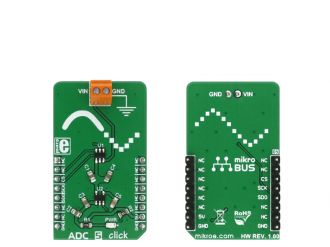
We strongly encourage users to use Package manager for sharing their code on Libstock website, because it boosts your efficiency and leaves the end user with no room for error. [more info]

Rating:
Author: MIKROE
Last Updated: 2018-03-13
Package Version: 1.0.0.0
mikroSDK Library: 1.0.0.0
Category: ADC
Downloaded: 6299 times
Not followed.
License: MIT license
ADC 5 click uses the ADC121S021 device from Texas Instruments - a low power, single channel 12-bit CMOS analog to digital converter, with a high-speed serial interface. This device uses the SAR algorithm for sampling the input voltage which, coupled with relatively high bit depth, gives a pretty accurate digital reconstruction of the input voltage.
Do you want to subscribe in order to receive notifications regarding "ADC 5 click" changes.
Do you want to unsubscribe in order to stop receiving notifications regarding "ADC 5 click" changes.
Do you want to report abuse regarding "ADC 5 click".


Library Description
Key Functions
adc5_getData- Returns raw 10-bit data
adc5_getVoltage- Returns measured voltage in millivolts
Examples Description
The demo application is composed of three sections:
void applicationTask()
{
ADC_Value = adc5_getVoltage();
WordToStr( ADC_Value, text );
mikrobus_logWrite( "Voltage:", _LOG_TEXT );
mikrobus_logWrite( text, _LOG_TEXT );
mikrobus_logWrite( " mV", _LOG_LINE );
Delay_1sec();
}
Other MikroElektronika libraries used in the example:
Additional notes and information
Depending on the development board you are using, you may need USB UART click, USB UART 2 click or RS232 click to connect to your PC, for development systems with no UART to USB interface available on the board. The terminal available in all MikroElektronika compilers, or any other terminal application of your choice, can be used to read the message.